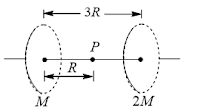JEE Advanced Physics Syllabus can be referred by the IIT aspirants to get
a detailed list of all topics that are important in cracking the entrance
examination. JEE Advanced syllabus for Physics has been designed in such a
way that it offers very practical and application-based learning to
further make it easier for students to understand every concept or topic
by correlating it with day-to-day experiences. In comparison to the other
two subjects, the syllabus of JEE Advanced for physics is developed in
such a way so as to test the deep understanding and application of
concepts.
Gravitation is an easy to understand and a highly scoring topic. It
might have a 1% weightage in the entire JEE Physics portion but do not
neglect. You can practice these questions on regular basis to know what
are the important points to remember at the moment when
gravitation question comes.
Q1.Two concentric shells have masses M and m and their radii
are R and r, respectively, where R>r. What is the
gravitational potential at their common centre?
Q2.The following figure shows two shells of masses m1
and m2. The shells are concentric. At which point,
a particle of mass m shall experience zero force?
Q3.Two rings having masses M and 2M, respectively, having the
same radius are placed coaxially as shown in the figure If the
mass distribution on both the rings is non-uniform, then the
gravitational potential at point P is
Q4.The gravitational force exerted by the Sun on the Moon is
about twice as great as the gravitational force exerted by the
earth on the Moon, but still Moon is not escaping from the
gravitational influence of the earth. Mark the option which
correctly explains the above system
Q5.A satellite of mass m revolves around the earth of radius
R at a height x from its surface. If g is the acceleration due
to gravity on the surface of the earth, the orbital speed of
the satellite is
Q7. If the mass of a planet is 10% less than that of the
earth and the radius is 20% greater than that of the earth,
the acceleration due to gravity on the planet will be
Q8.A satellite is moving with a constant speed v in a
circular orbit about the earth. An object of mass m is ejected
from the satellite such that it just escapes from the
gravitational pull of the earth. At the time of its ejection,
the kinetic energy of the object is
Q9.A solid sphere of radius R/2 is cut out of a solid sphere
of radius R such that the spherical cavity so formed touches
the surface on one side and the center of the sphere on
the other side, as shown. The initial mass of the
solid sphere was M. If a particle of mass m is placed at
a distanace 2.5 R from the center of the cavity, then
what is the gravitational attraction on the mass m?
Q10.The gravitational potential of two homogenous spherical
shells A and B of same surface density at their respective
centres are in the ratio 3:4. If the two shells coalesce into
a single one such that surface charge density remains the
same, then the ratio of potential at an internal point of the
new shell to shell A is equal to


















